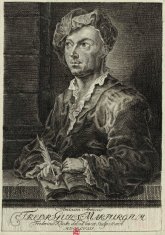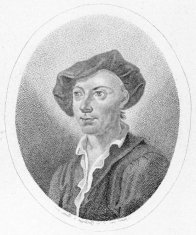|
|
Friedrich Wilhelm Marpurg (Music Critic, Music Theorist, Composer, Copyist, Bach's Pupil) |
|
Born: November 21, 1718 - Seehof in Wendemark (Altmark), Saxony-Anhalt, Germany
Died: May 22, 1795 -Berlin, Germany |
|
Friedrich Wilhelm Marpurg was a German music critic, music theorist and composer. He was friendly and active with many figures of the Enlightenment of the 18th century. Little is known of Marpurg's early life. Around 1737 he stayed in the Altmark. He studied at Universität Jena (enrollment on May 8, 1738) and Universität Halle (enrollment on July 7, 1739); According to various sources, he studied "philosophy" and music. It is clear that he enjoyed a strong education and was friendly with various leading figures of the Enlightenment, including Winckelmann and Lessing. From 1740 to 1747 he stayed in France. In 1746, he travelled to Paris as the secretary for a General named either Rothenberg or Bodenberg. There, he became acquainted with important intellectual luminaries, such as the writer and philosopher Voltaire, the mathematician d'Alembert and the composer Jean-Philippe Rameau.
After 1746, Friedrich Wilhelm Marpurg returned to Berlin where he was more or less independent. He studied in Frankfurt / Oder (enrolled on April 6, 1748). From 1749 to 1751 he was Secretary of General Friedrich Rudolf Graf Rothenburg in Berlin. He worked as private scholar and publicist in Berlin. His offer to write exclusively for Breitkopf & Härtel was declined by the firm in 1757. In 1760, he received an appointment to the Royal Prussian Lotteries, whose director he became in 1763, receiving the title of War Councillor in 1766. His son, Johann Friedrich Marpurg, who later became a celebrated violinist, was born in 1766.
Marpurg's quarrelsome disposition and his enthusiasm for public polemics made him many enemies. Contemporaries also described him, however, as courteous and open-hearted.
Friedrich Wilhelm Marpurg is most likely at the source of a two-centuries misunderstanding that J.S. Bach would have been using the equal temperament for the performance of Das Wohltemperirte Clavier, because of his publication Versuch über die musikalische Temperatur, 1776, This misunderstanding was only much later first challenged by Robert Holford Bosanquet in An Elementary Treatise on Musical Intervals and Temperament 1876, pp. 29-30, but this position did not acquire fame. The above position of Bosanquet, that a distinction should be made between "well temperament" and "equal temperament" was rediscovered by H. Kelletat, and thoroughly defended and analysed historically in Zur musikalischen Temperatur, 1960, especially p. 32. Thanks to this publication by H. Kelletat, almost all musicologists subscribe to this distinction nowadays.
Friedrich Wilhelm Marpurg published the bulk of his writings on music between 1750 and 1763. After he had attained his lottery position in 1763, he penned two works on this topic but continued to write on wider areas of music. One of the first (and most influential) works of Marpurg was his tract on the Fugue (1753) which is considered one of the oldest sources for the performance practice of J.S. Bach's Art of the Fugue. His Handbuch bey dem Generalbasse und der Composition and the translation of d'Alembert's Elémens de musique stand at the beginning of Rameau reception in German harmonic theory. Other works treat questions of instrumental performance, vocal music, music history and mathematical music theory. His journal projects continued to promote the institution of German music criticism in the wake of Johann Mattheson and Johann Adolph Scheibe; his Kritische Briefe über die Tonkunst contains significant contributions to the theory of meter, the esthetics of the ode and other topics of current interest. His manuscript work on the ancient water organ remained unfinished. The scope and unprecedented clarity of Marpurg's writings on music made him the leading German music theorist of the late 18th century; he and his rivals Johann Philipp Kirnberger and Schulz made up a distinct "Berlin School" of music criticism and -theory.
A possible study of Friedrich Wilhelm Marpurg with J.S. Bach was occasionally hinted at. According to a statement by F.W. Marpurg from 1750, however, only an encounter with J.S. Bach towards the end of the 1740's. In view of the saved biographical data, a student relationship could have been established for a short time between 1747 and 1749. He is identified in J.S. Bach's manuscripts as Anonym II; Anonym III.
References: Koska: B-43; GND: 118921088; Bach Digital: 00003573 |
|
Works of Bach he copied [Manuscript No. in Bach Digital / Work / Copy date] |
|
D-B Am.B 40-42, Faszikel 3: BWV 236/1
GB-Lcm MS 26: BWV 870b/2, 871/2, 874/2, 875/2, 876/2, 877/2, 878/2, 879/2, 880/2, 881/2, 882/2, 883/2, 884/2, 885/2, 886/2, 887/2, 888/2, 889/2, 890/2, 891/2, 892/2, 893/2
US-BEm MS 838: BWV 1080/19 (nur T. 233-239), BWV 668a (1752?) |
 |

|
|
|
Friedrich Wilhelm Marpurg: Etching by Berol after a
drawing by Friedrich Kauke (1758) [01] |
Kupferstich von Friedrich Wilhelm Bollinger [02] |
|
|
Sources:
1. Wikipedia Website (February 2019)
2. Bernd Koska: Bachs Privatschüler in Bach-Jahrbuch 2019, English translation by Aryeh Oron (May 2020)|
3. Bach Digital Website (May 2019)
Contributed by Aryeh Oron (August 2019, May 2020) |
|
Use of Chorale Melodies in his works |
|
Jesu, Meine Freude , Chorale Prelude for organ (CM: Jesu, meine Freude) |
|
Links to other Sites |
|
Friedrich Wilhelm Marpurg (Wikipedia) [English]
Friedrich Wilhelm Marpurg (Wikipedia) [German]
Marpurg, Friedrich Wilhelm (Bach digital)
Marpurg, Friedrich Wilhelm | Grove Music (Oxford Music Online) |
|
Bibliography |
|
Allgemeine deutsche Real-Encyklopädie für die gebildeten Stände. Conversations-Lexikon (Leipzig, F. A. Brockhaus 1853)
Sources 2: C. Wolff, Johann Sebastian Bach, Frankfurt/Main 2000, S. 330f.; Dok III, Nr. 632; Gerber ATL, Bd. I, Sp. 882–884; Gerber NTL, Bd. II, Sp. 529–334; MGGo; BJ 2004, S. 121–132 (H.-J. Schulze); BJ 2011, S. 27–33 (H.-J. Schulze)
References 3: NBA I/40; II/2; III/2.2, 3; IV/1, 5, 6, 7; V/2, 5–6.2, 8–10, 12; VIII/1, 2; IX/2; Suppl.; BR II; III/2; IV; Dok I, II, III, V, VI, VII |
|
|